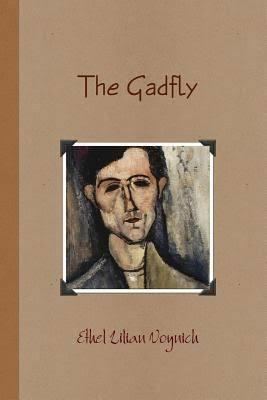7 /10 1 Votes
Country United States Publication date June, 1897 Publisher Henry Holt and Company | 3.5/5 ManyBooks Language English Originally published June 1897 Genre Novel | |||||||||||||||||||||||||||||||||
 | ||||||||||||||||||||||||||||||||||
Media type Print (hardback and paperback) Pages 373 pp (first edition hardcover) Adaptations The Gadfly (1956), The Gadfly (1980) Novels How the Steel Was Tempered, The Thorn Birds, Three Comrades, Gone with the Wind, The Red and the Black | ||||||||||||||||||||||||||||||||||
Dmitri shostakovich 1906 1975 the gadfly suite 1955 homage to great youtubers imusiciki
The Gadfly is a novel by Irish writer Ethel Voynich, published in 1897 (United States, June; Great Britain, September of the same year), set in 1840s Italy under the dominance of Austria, a time of tumultuous revolt and uprisings. The story centres on the life of the protagonist, Arthur Burton, as a member of the Youth movement, and his antagonist, Padre Montanelli. A thread of a tragic relationship between Arthur and his love Gemma simultaneously runs through the story. It is a story of faith, disillusionment, revolution, romance, and heroism.
Contents
- Dmitri shostakovich 1906 1975 the gadfly suite 1955 homage to great youtubers imusiciki
- Themes
- Plot
- Background
- Popularity
- Theatre adaptations
- Opera ballet musical adaptations
- Film adaptations
- References
Themes
The book, set during the Italian Risorgimento, is primarily concerned with the culture of revolution and revolutionaries. Arthur, the eponymous Gadfly, embodies the tragic Romantic hero, who comes of age and returns from abandonment to discover his true state in the world and fight against the injustices of the current one. The landscape of Italy, in particular the Alps, is a pervading focus of the book, with its often lush descriptions of scenery conveying the thoughts and moods of characters.
Plot
Arthur Burton, an English Catholic, travels to Italy to study to be a priest. He discovers radical ideas, renounces Catholicism, fakes his death and leaves Italy. While away he suffers great hardship, but returns with renewed revolutionary fervour. He becomes a journalist, expounding radical ideas in brilliant satirical tracts published under the pseudonym "the gadfly". The local authorities are soon dedicated to capturing him. Gemma, his lover, and Padre Montanelli, his Priest (and also secretly his biological father), show various forms of love via their tragic relations with the focal character of Arthur: religious, romantic, and family. The story compares these emotions to those Arthur experiences as a revolutionary, particularly drawing on the relationship between religious and revolutionary feelings. This is especially explicit at the climax of the book, where sacred descriptions intertwine with reflections on the Gadfly's fate. Eventually Arthur is captured by the authorities and executed by a firing squad. Montanelli also dies, having lost his faith and his sanity.
It is debatable to what extent an allegorical comparison can be drawn between the Gadfly and Jesus.
Background
According to historian Robin Bruce Lockhart, Sidney Reilly – a Russian-born adventurer and secret agent employed by the British Secret Intelligence Service – met Ethel Voynich in London in 1895. Ethel Voynich was a significant figure not only on the late Victorian literary scene but also in Russian émigré circles. Lockhart claims that Reilly and Voynich had a sexual liaison and voyaged to Italy together. During this dalliance, Reilly apparently "bared his soul to his mistress," and revealed to her the story of his strange youth in Russia. After their brief affair had concluded, Voynich published in 1897 her critically acclaimed novel, The Gadfly, the central character of which, Arthur Burton, was allegedly based on Sidney Reilly's own early life. However, Andrew Cook, a noted biographer of Reilly, calls Lockhart's romanticised version of such events doubtful, and counters instead that Reilly was perhaps informing on Voynich's radical, pro-émigré activities to William Melville of the Metropolitan Police Special Branch.
Popularity
With the central theme of the book being the nature of a true revolutionary, the reflections on religion and rebellion proved to be ideologically suitable and successful. The Gadfly was exceptionally popular in the Soviet Union, the People's Republic of China and Iran exerting a large cultural influence. In the Soviet Union The Gadfly was compulsory reading and the top best seller, indeed by the time of Voynich's death The Gadfly is estimated to have sold 2,500,000 copies in the Soviet Union alone. Irish writer Peadar O'Donnell recalls the novel's popularity among Republican prisoners in Mountjoy Prison during the Irish Civil War.
The Russian composer Mikhail Zhukov turned the book into an opera The Gadfly (Овод, 1928). In 1955, the Soviet director Aleksandr Faintsimmer adapted the novel into a film of the same title (Russian: Ovod) for which Dmitri Shostakovich wrote the score. The Gadfly Suite is an arrangement of selections from Shostakovich's score by the composer Levon Atovmian. A second opera The Gadfly was composed by Soviet composer Antonio Spadavecchia.
On the other hand, in Italy, where the plot takes place during the Italian Unification, the novel is totally neglected: it was translated into Italian as late as in 1956 and was never reprinted: Il Figlio del Cardinale (literally, The Son of the Cardinal). A new edition, carrying the same title, came out in 2013.
